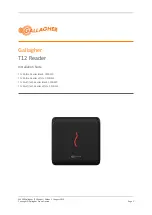
Operating instructions
Chapter
8
ICR 84x Image Code Reader
Troubleshooting
8 010 961/0000/10-05-2005
©
SICK AG · Division Auto Ident · Germany · All rights reserved
8-9
8.5.3
Malfunctions in Reading mode: Result output errors
Prerequisite
The “Device Ready“ LED lights up. If not, see
.
The reading pulse is functioning correctly. If not, see
.
General malfunctions
Fault
Possible cause
Remedy
No Read:
1. The “Result“ LED (default setting: “Good
Read“) does not light up at the end of the
reading pulse.
– The “Result 2“ switching output
(default setting: “Good Read“) does
not output a pulse
– The ICR outputs the status ST = 2 in
the reading result of the host interface
(if ST is enabled for output in the
Reading data on the D
ATA
S
TRINGS
tab;
this is not selected in the default
setting)
– The ICR outputs the system message
“no code“ via the auxiliary interface
(Terminal Emulator of CLV Setup)
•
Read not successful, since there was no
code stationary in the illumination field
during the reading pulse
•
Code not completely within the distance-
dependent reading surface (red
illumination field positioned incorrectly)
•
Code presented at incorrect reading
distance
•
Evaluation range of the reading area in
the image memory was incorrectly
limited (image geometry or area of
interest)
•
Insufficient light on the reading area
•
Perform the reading while the code is
stationary. Check the content of the
image memory with CLV Setup/
ImageFTP: trigger the ICR; is the code in
the image memory once the reading
cycle is complete?
•
Align ICR: reading area 40 mm x
32 mm (1.58 in x 1.27 in) at reading
distance 80 mm (3.15 in) (see also
). Is the code in the
center of the illumination field?
For remedy, see above.
If necessary, call up P
ERCENTAGE
E
VALUATION
(see
“Percentage Evaluation“, Page 6-34
•
Check: reading distance of code in
specified reading range?
ICR 840 (standard type) with side/front
reading window: 80 mm (3.15 in).
See also
Check with image output via ImageFTP:
Is the code recorded in sharp focus in
the image memory?
•
Check with image output via ImageFTP:
Has all the code been recorded in the
image memory?
Check in the CLV Setup program:
Select the R
EADING
C
ONFIGURATION
tab,
click the C
ODE
PROPERTIES
P
ARAMETERS
button, find the I
MAGE
G
EOMETRY
group:
Active evaluation range ok?
Select the R
EADING
C
ONFIGURATION
tab.
Find the A
REA
OF
INTEREST
group: Are the
min. and max. code position values
correct?
•
Check in the CLV Setup program:
Select the R
EADING
C
ONFIGURATION
tab,
click the C
ODE
PROPERTIES
P
ARAMETERS
button, find the I
NTERNAL
I
LLUMINATION
MODE
group: is the number of selected
segments sufficient?
See also
Chapter “f) Illumination mode“,
.
Table 8-5: Troubleshooting: Result output errors in Reading mode (general malfunctions)
















































